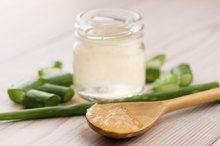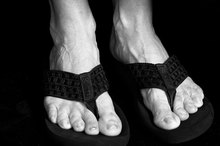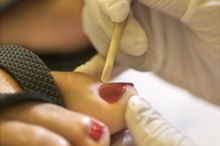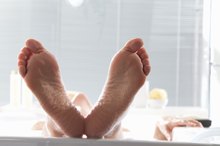Dry Skin on the Sole of the Foot
Dry skin on the feet is a common problem, especially older people with poor circulation. The feet support the weight of the body and the pressure of this weight causes dry skin. On top of that, the feet are wrapped up in socks and shoes all day. Moisture is lost due to perspiration, and this can lead to dry skin on the soles of the feet.
Causes
Patches of dry skin form on the soles of the feet where the thickest layers of dead skin exist.
Dry skin occurs because of sweating and the associated moisture lost from the body and from the pressure of body weight on the feet.
During dry and cold weather, the skin becomes dry. Skin gets drier as we age. Common skin disorders such as dermatitis, athlete's foot, eczema, and psoriasis can also cause dry skin.
- Patches of dry skin form on the soles of the feet where the thickest layers of dead skin exist.
- Dry skin occurs because of sweating and the associated moisture lost from the body and from the pressure of body weight on the feet.
Significance
How to Treat Cracked Diabetic Feet
Learn More
Dry skin on the soles of the feet can cause itching and burning sensations. Any change in the skin, such as redness, itching, flaking or rashes can indicate infection.
Even worse, if the symptoms are not treated, dry skin can lead to fissures, or deep cracks in the skin, which become sore.
If a fissure is untreated, it can cause infection. Fissures usually occur on the heel, but they can develop in other callused or dry areas, such as the sole of the feet. If the dry skin on the soles of the feet begins to crack or bleed, consult a doctor. Fungal infections or bacteria can be caught through cracked skin.
- Dry skin on the soles of the feet can cause itching and burning sensations.
- Even worse, if the symptoms are not treated, dry skin can lead to fissures, or deep cracks in the skin, which become sore.
Identification
The circulatory system of the body supplies blood to the feet and toes through tiny blood vessels. **As we age, circulation to the feet becomes less efficient.
** Since the feet are at the lower extremity, they provide signals about what is happening to the body.
The skin on the soles of the feet becomes dry and brittle, indicating a weak circulatory system. Check feet twice daily for cracks and dryness. Keeping an eye on the skin is the key to health.
Ensure that you understand what is normal for the feet 2. Consult a professional manicurist to identify potential problems or schedule an appointment with a podiatrist or dermatologist.
- The circulatory system of the body supplies blood to the feet and toes through tiny blood vessels.
- Since the feet are at the lower extremity, they provide signals about what is happening to the body.
Prevention
How to Get Rid of Dead Skin on Feet
Learn More
Prevent dry skin on the soles of the feet by drinking plenty of water, preferably eight glasses or more a day. When you get home, air out your feet--remove your shoes and socks 2.
Wash your feet with a mild soap, but do not use hot water every day 2. **It can cause dryness especially when combined with harsh soaps.
After bathing, do not rub your skin dry with the towel. ** Instead, use a gentle patting motion.
After bathing, rub oil on your feet. Use any oil such as soy, sunflower or safflower, and give it a few minutes to absorb into the skin before wiping off the excess. Do not add oil to the bath water, because it can make the feet and the bathtub slippery.
If you have poor circulation, get more cardiovascular exercise, such as walking.
Bad circulation leads to dry skin because the sweat glands on the feet secrete less fat because the nerves of the skin receive a reduced blood flow. Ask your doctor about an activity program that is right for you.
- Prevent dry skin on the soles of the feet by drinking plenty of water, preferably eight glasses or more a day.
- Wash your feet with a mild soap, but do not use hot water every day 2.
Treatment
The best initial approach to treating this dry skin problem is to consult a professional manicurist.
The beautician will soak your feet in a whirlpool bath, remove calluses, exfoliate (brush away) dry skin and give a relaxing foot massage or perhaps use a paraffin dip on the feet. The cost varies but usually starts at $40, as of 2010.
To treat your dry skin at home, buy a foot file (a large two-sided plastic emery board) at a drugstore. Gently brush the rough side across your feet to remove the dry skin particles, followed by a quick brush with the smooth side. Apply about a nickel-sized amount of a thick foot balm to each foot and massage until the balm is absorbed.
Look for a product with honey, beeswax and multivitamin complexes to seal over the cuts or cracks on the soles of the feet. Another good ingredient is salicylic acid, which works to soften calluses.
- The best initial approach to treating this dry skin problem is to consult a professional manicurist.
- The beautician will soak your feet in a whirlpool bath, remove calluses, exfoliate (brush away) dry skin and give a relaxing foot massage or perhaps use a paraffin dip on the feet.
Related Articles
References
- "The Little Foot Care Book"; Erika Dillman; 2000
- "How To Keep Your Feet & Legs Healthy For A Lifetime"; Gary Null; 1990
- "The Good Foot Book"; Glenn Copeland, DPM; 2005
- Institute For Preventive Foot Health. National Foot Health Assessment 2012. 2012.
- Boutrand LB, Thépot A, Muther C, et al. Repeated short climatic change affects the epidermal differentiation program and leads to matrix remodeling in a human organotypic skin model. Clin Cosmet Investig Dermatol. 2017;10:43-50. doi:10.2147/CCID.S120800
- Kapur S, Watson W, Carr S. Atopic dermatitis. Allergy Asthma Clin Immunol. 2018;14(Suppl 2):52. doi:10.1186/s13223-018-0281-6
- Safer JD. Thyroid hormone action on skin. Dermatoendocrinol. 2011;3(3):211-215. doi:10.4161/derm.3.3.17027
- Hashizume H. Skin aging and dry skin. J Dermatol. 2004;31(8):603-609. doi:10.1111/j.1346-8138.2004.tb00565.x
- Parker J, Scharfbillig R, Jones S. Moisturisers for the treatment of foot xerosis: a systematic review. J Foot Ankle Res. 2017;10:9. doi:10.1186/s13047-017-0190-9
- Linus Pauling Institute. (2012-2016). Oregon State University: Micronutrient Information Center: Essential Fatty Acids and Skin Health.
Writer Bio
Based in Seattle, Greg Van Pelt has been writing technical documentation since 1997. His work has appeared in product documentation for various enterprise software companies from the Fortune 500. Mr. Van Pelt holds a Bachelor of Science in professional writing from the University of Houston.







